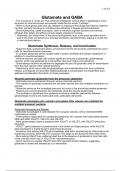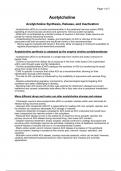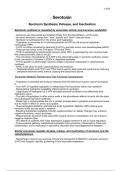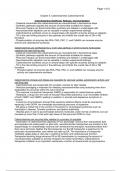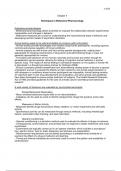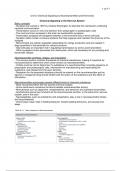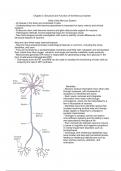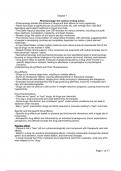Athabasca University (AU ) • Psychology
Latest uploads for Psychology at Athabasca University (AU ). Looking for Psychology notes at Athabasca University (AU )? We have lots of notes, study guides and study notes available for Psychology at Athabasca University (AU ).
-
13
- 0
-
2
Courses Psychology at Athabasca University (AU )
Notes available for the following courses of Psychology at Athabasca University (AU )
Latest content Athabasca University (AU ) • Psychology
Terminology definitions, Learning Objectives, and study questions for the course study guide. Great to print out for final exam study prep.
Chapter 8 provides an extensive overview of the roles of the neurotransmitters glutamate and GABA in the central nervous system. It delves into these neurotransmitters' synthesis, release, and inactivation processes, emphasizing their critical functions in excitatory and inhibitory neural transmission, respectively. The chapter highlights the mechanisms of excitotoxicity caused by excessive glutamate stimulation, which can lead to neuronal damage and death. This phenomenon is implicated in vari...
Chapter 7 on acetylcholine provides a comprehensive overview of the role and mechanisms of this essential neurotransmitter. It discusses the synthesis of acetylcholine (ACh) by the enzyme choline acetyltransferase from choline and acetyl coenzyme A and how its production is influenced by precursor availability and neuronal activity. The chapter also covers the storage and release of ACh in synaptic vesicles and the impact of various drugs and toxins on these processes, highlighting the effects o...
Chapter 6 - Serotonin provides a comprehensive overview of serotonin, covering its synthesis, release, inactivation, and functional roles within the brain and body. The chapter begins with a detailed explanation of serotonin synthesis, emphasizing the conversion of tryptophan to serotonin through the action of specific enzymes like tryptophan hydroxylase (TPH) and aromatic amino acid decarboxylase (AADC). It highlights the importance of dietary tryptophan and discusses various factors affecting ...
Chapter 5 focuses on catecholamines, a group of neurotransmitters that include dopamine, norepinephrine, and epinephrine. The chapter begins by discussing the synthesis of catecholamines, outlining the multi-step biochemical pathways that convert tyrosine to dopamine, norepinephrine, and epinephrine. It emphasizes the role of specific enzymes, such as tyrosine hydroxylase, which catalyzes the rate-limiting step in catecholamine synthesis. The regulation of these synthetic pathways is also covere...
Chapter 4 of the document "Techniques in Behavioral Pharmacology" focuses on various methodologies utilized to evaluate animal behaviour in the context of behavioural pharmacology. The chapter emphasizes the importance of animal studies for understanding the neurochemical basis of behaviour and developing models for psychiatric disorders. Techniques discussed include simple behavioural observation, motor activity measures, and operant conditioning. The chapter highlights how these methods allo...
Chapter 3 delves into the intricate mechanisms of chemical signalling by neurotransmitters and hormones within the nervous system. It begins with the basic concepts of synaptic transmission, highlighting the directionality from presynaptic to postsynaptic cells and the structural components of synapses, such as axodendritic and axosomatic synapses. The chapter further explores neurotransmitters' synthesis, release, and inactivation, noting the diverse chemical classes, including amino acids, mo...
Chapter 2 of the document explores the structure and function of the nervous system, focusing on the fundamental roles of neurons and glial cells. It begins by discussing the differentiation of embryonic stem cells into neurons and glial cells, which provide essential support to neurons. The chapter outlines the major external features of neurons, including the soma, dendrites, and axon, and emphasizes the significance of the semipermeable membrane, mitochondria, and ATP synthesis in neuron func...
Chapter 1 of the document delves into the fundamental aspects of pharmacology, the science of drug action. It highlights the historical use of plants in medicine, referencing ancient Egyptian and Indian texts that detail remedies for various ailments. The chapter also emphasizes the ongoing reliance on herbal medicines in many parts of the world, including the United States, where natural products were prominent in the late 1990s. It introduces specialized fields, such as neuropharmacology and p...
Psyc 304 Final exam-Research Methods in Psychology (Athabasca University) 1. What is the difference between empirical and non-empirical methods of knowing about behaviour? a. Empirical methods are based off of experiences i. Intuition-judgement not based on reasoned steps ii. Common sense- intelligence shared by a large group of people b. Non empirical methods are based off of logic i. Authority- based on someone else's knowledge ii. Logic - based on deductive and non deductive reasonin...


